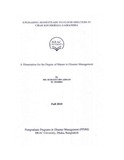| dc.description.abstract | Bangladesh is known as a riverine country, and has a dense concentration of water bodies. Every
year flood inundates most of the part of the country. In this country, there are many rivers, with
three major rivers, along with many of the medium size and a lot of small tributaries. Over 250
rivers exist in this country. With all these rivers flowing, there is the presence of many char areas
adjacent to the rivers. Due to the flooding in a yearly basis, the char dwellers suffer directly from
the devastating consequence. This is why, these people have to constantly acclimatize with the
detrimental effects of the annual flooding.
A char is basically a pile of land which is formed by the deposition of sediment for a long period
of time. The char land is extremely fertile and has an extremely efficient productivity due to the
storage of sediment. The char land is generally not an even chunk all throughout, and has various
undulations. Field visits were made on the `Char' area of `Fulchari' upazila of Gaibandha district.
It
was found that over 400 families live in the char, among which 150 families live on the higher
land and around 50 families live in middle land. The rest of the dwellers live on the vulnerable
low lands mostly prone to extensive flooding. Char dwellers livelihood mostly depends on
agriculture, fisheries, daily labour works and other small business. People of the char lives on a
char because they believe that even if they loose land after a flood, another piece of land will rise
in return.
There were many occurrences of extensive flooding in the past, the flood of 1998 being one of the
most devastating ones. The government and various other organizations have worked on the
efficiency of rehabilitation of the flood affected people. But due to the lack of technology and the
lack of co-ordination, the progress in addressing the problem is moving in a snail's pace. No work
policies have been thought about for the char dwellers in the agenda. In the light of this objective
being neglected, this study has been conducted. In the study char area, man;, resources and
materials have been found which the people are generally using for their living and housemaking.
In the particular char Kochkhali the dwellers are predicting that the chunk of land will survive for
another 5 to 6 years. This prediction has drawn people from other chars to come and settle there.
The generally accepted situation that the char dwellers have to cope with is the lack of
communication, education and various activities that may generate income due to loss of valuable
fertile land. All these culminate into the results which show that the lack of organized settlement
pattern and the lack of technology of making stronger and safer homestead is an issue that makes
the char dwellers vulnerable due to flooding.
Vegetation is profoundly found all over the char areas, owing to the fertility of the soil of the
char. People do vegetation in their surroundings, on the roof and also on bamboo sheds, which
fulfill their daily food need. Using all these resources and materials, there can be ways to make an
individual homestead both flood protective and economically sustainable with a little bit of
knowledge on technology and efficient usage of the available raw materials. So this can be a way
of mitigation of flood.
This study was to find out a way of making an individual homestead as a flood protective shelter.
Through the study, the needs, the habits, the daily life cycle, the hardships and the expectations of
the char dwellers were observed and analyzed. The main purpose of the study was to come up
with some ideas as to how these people can survive better in the worst possible conditions. | |

